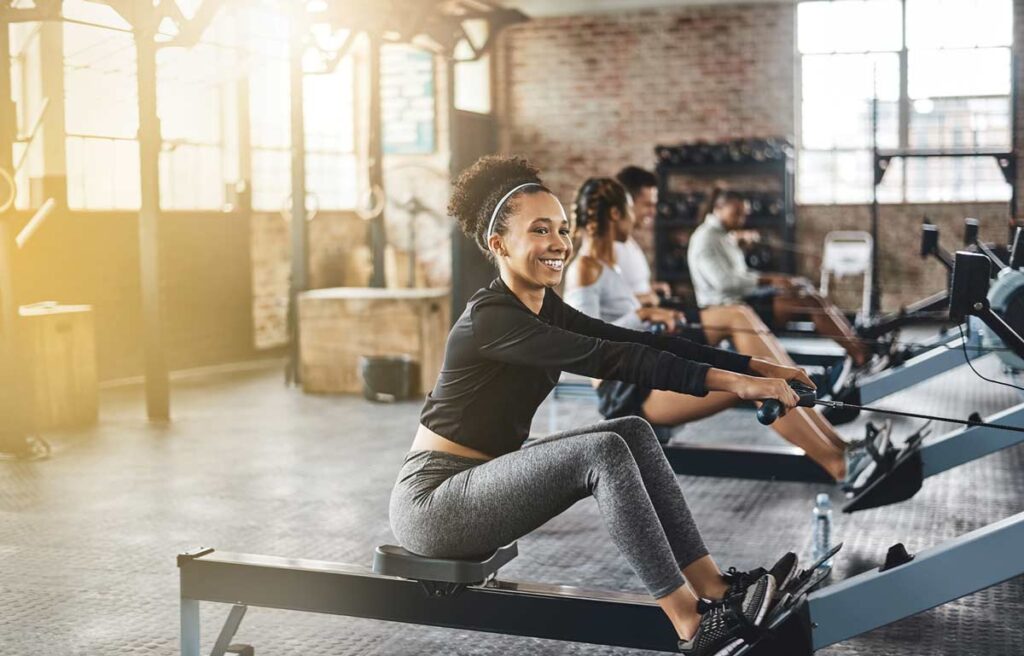
Using the rowing machine, also known as an ergometer (erg), is a great way to get a full-body workout. However, it is crucial to use the proper technique in order to get an effective workout.
Technique
The row stroke has four components: catch, drive, finish, and recovery.
Catch: The catch is where you begin the stroke. Your seat should be up the slide (toward the monitor), and your legs should be perpendicular to the ground; it’s okay if your heels are lifted off the footplates. Hinge at the hips and lean your upper body forward. Keep your arms straight (without locking your elbows) and wrists flat and level. Hold your head in a neutral position and keep your shoulders level; do not hunch.
Drive: During the drive, you push (or drive) yourself down the slide. Push off your legs first; most of the power in a stroke comes from your legs. Then, move your upper body (still hinging at the hips) so that you lean slightly backward, engaging your core. The last motion of the drive is pulling your arms, ensuring that they stay level.
Finish: The finish is the end of the stroke. Your upper body should be leaning slightly backward, while maintaining a straight back; do not lean too far back, as that weakens the stroke. Your legs should be fully extended without locking your knees. The handle should be at mid-torso level (level with the band of a sports bra), and wrists should be flat.
Recovery: The recovery is the movement up the slide, returning to the catch. The motions for the recovery are the inverse of the drive: arms, then upper body, then legs. Extend your arms, then lean forward, hinging at the hips. Finally, bend your legs to bring the seat up the slide and return to the catch.1,2
Take it slowly at first to make sure you understand the technique; it is much harder to maintain your form at higher intensities, so a good foundation is key to effective workouts.
Common mistakes
Tense grip: Don’t hold the handle too tightly. You should be able to row with your thumbs hanging off the handle.
Bending arms too early on the drive: Make sure you complete the leg motion before bending your arms to pull back the handle.
Using your back on the drive: The drive should be powered by your legs; do not use your back, or else you could injure yourself.
Bending knees too early on the recovery: Make sure your arms are extended before beginning to move up the slide to avoid knocking your knees into your arms.
Rushing up the slide: Remember to use the recovery to recover; you’ll tire yourself out if you rush.
Overcompression at the catch: Don’t overcompress or let your shins go past perpendicular at the catch, as this weakens the drive.2
Reading the monitor
Monitor menu:
- Just Row: Default screen if you row without selecting a specific workout.
- Select Workout: Choose from preset workouts or make your own time and/or distance workouts, with or without intervals.
- Memory: Shows data from previous workouts; you can use this screen to see a more detailed breakdown of your workout.
- Upper section of Just Row screen (above the thick black line):
- Top right: Stroke rate, measured in strokes per minute (s/m)
- Top left: Time elapsed
- Middle: Split time per 500m, or the time it takes to row 500m; the lower your split time, the faster you’re rowing.
- Bottom: Meters rowed
- The monitor displays more data, but this is the basic information needed for tracking your progress.
Damper and Stroke Rate
The damper is the handle on the flywheel housing; it controls how much air goes into the cage. It can be set from 1 to 10, with lower settings allowing for a more aerobic workout and higher settings allowing for a more strength-based workout. It is recommended to start with the damper setting at 3 to 5. Be cautious of setting the damper too high, as it can wear you out quickly.3
Damper setting does not equal workout intensity; intensity depends on how hard you pull. At lower settings, the challenge lies in the need to apply force more quickly to accelerate the flywheel.3,4
A higher stroke rate does not necessarily mean a better or more intense workout; it is more important to focus on the power of the drive than the number of strokes you take.4 At low stroke rates (18–22 s/m), it takes more effort to get to a lower split time. Rowing at a low stroke rate is helpful for refining your technique and rhythm. Moderate stroke rates (24–28 s/m) are useful for steady state/endurance-based workouts, providing a challenge while still allowing you to focus on maintaining good form. Higher stroke rates (30–36 s/m) are best for short distances, such as during interval workouts or sprints during longer workouts (e.g., 2000m race).5
Editor’s note. The information presented in this article is based on a Concept2 Model C or later rowing machine. Other types of rowing machines might have slight differences in setup and display.
Sources
- Concept2. Indoor rowing technique. https://www.concept2.com/indoor-rowers/training/technique-videos. Accessed 26 Mar 2024.
- Concept2. Common errors. https://www.concept2.com/indoor-rowers/training/technique-videos/common-errors. Accessed 26 Mar 2024.
- Concept2. Damper setting 101. https://www.concept2.com/indoor-rowers/training/tips-and-general-info/damper-setting-101. Accessed 26 Mar 2024.
- Concept2. Debunking the myths: damper setting, stroke rate, and intensity. 13 Aug 2013. https://www.concept2.com/news/debunking-myths-damper-setting-stroke-rate-and-intensity. Accessed 26 Mar 2024.
- Breiland M. Rowing stroke rate explained. Concept2. 1 Dec 2017. https://www.concept2.com/news/rowing-stroke-rate-explained. Accessed 26 Mar 2024.





